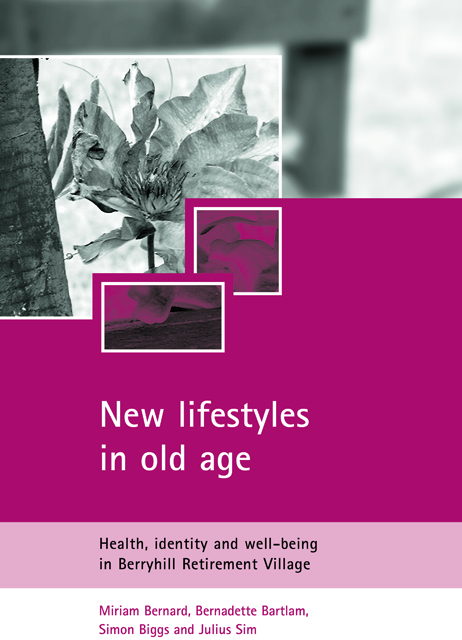Book contents
- Frontmatter
- Contents
- List of tables and figures
- Acknowledgements
- A day in the life of a retirement community resident
- 1 Retirement communities: the context
- 2 Developing a retirement community lifestyle: participation and involvement
- 3 Health and well-being
- 4 Growing older: age and identity
- 5 Conclusions
- References
- Appendix A Research questions
- Appendix B The study’s timeline
- Appendix C Questionnaires
- Appendix D Interviews
- Appendix E Participation groups and community conferencing
2 - Developing a retirement community lifestyle: participation and involvement
Published online by Cambridge University Press: 06 April 2023
- Frontmatter
- Contents
- List of tables and figures
- Acknowledgements
- A day in the life of a retirement community resident
- 1 Retirement communities: the context
- 2 Developing a retirement community lifestyle: participation and involvement
- 3 Health and well-being
- 4 Growing older: age and identity
- 5 Conclusions
- References
- Appendix A Research questions
- Appendix B The study’s timeline
- Appendix C Questionnaires
- Appendix D Interviews
- Appendix E Participation groups and community conferencing
Summary
Introduction
This chapter turns the spotlight on the means by which older people are enabled to play a part in actively creating a new retirement village lifestyle for themselves. Retirement communities like Berryhill are centrally concerned with the well-being and quality of life of residents. One way in which this is addressed is through encouraging and facilitating the participation and involvement of people in village life in particular, and community life more generally. Drawing on both qualitative and quantitative data, this chapter explores:
Berryhill: The Greenhouse
• use of and satisfaction with the village and its amenities;
• activities and interest groups;
• getting out and about;
• volunteering;
• contact with family and friends;
• democratic decision making.
It considers who participates in activities, what benefits residents gain from their involvement, and what some of the barriers to further participation might be. We look too at how some of these aspects have changed and modified over time, and at what stakeholders think about these features of retirement community living.
Village amenities: use and satisfaction
Chapter 1 showed that residents have access to a wide variety of on-site amenities, most of which are not routinely found in traditional forms of accommodation and care for older people. In the questionnaires, we asked people to tell us whether they knew about and used 14 of the amenities and, if so, how satisfied they were with them.
Table 2.1 shows that respondents who used the amenities rated them all very highly, giving them an average satisfaction score of at least 8 out of 10 (10 = completely satisfied). There were no differences in satisfaction scores between men and women. The hairdresser, restaurant, shop and bar are the most well-known amenities and were used consistently by between half and two thirds of respondents over the three years of the study. These amenities are all located off the main street in the village. Consequently, they are visible and easily accessible settings for people to meet and mix informally.
Most of the other facilities were only used by small numbers of people even if they knew of them. For example, about one in five respondents used the gym, while use of the craft room dropped from two in five, to one in five over the three years.
- Type
- Chapter
- Information
- New Lifestyles in Old AgeHealth, Identity and Well-being in Berryhill Retirement Village, pp. 12 - 23Publisher: Bristol University PressPrint publication year: 2004

